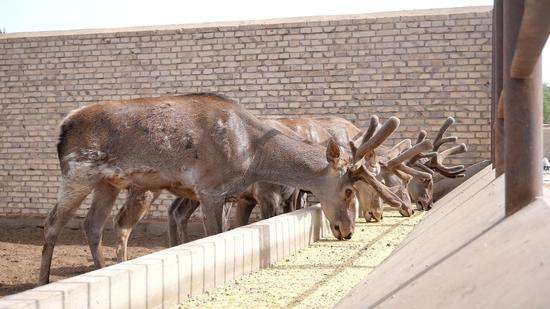Bactrian Deer
IUCN
LCBasic Information
Scientific classification
- name:Bactrian Deer
- Scientific Name:Bactrian Deer,Cervus elaphus yarkandensis,Cervus affinis yarkandensis,Cervus yarkandensis,Tarim subspecies of red deer, Tahe red deer, southern Xinjiang red deer, southern Xinjiang small white deer, Y
- Outline:Ungulata
- Family:Artiodactyla S.Rumina Cervidae S.Cervidae G.Cervidae
Vital signs
- length:108-138cm
- Weight:208-256kg
- lifetime:20-25years
Feature
It is a subspecies of red deer endemic to Xinjiang
Distribution and Habitat
Distributed in the Tarim region of Xinjiang, China.
Under natural conditions, the original poplar forests, secondary poplar forests, shrubs and grasslands in the green corridor along the Tarim River are the main habitats for the reproduction of wild Tarim red deer.
Appearance
Tarim red deer are compact and strong, with a proud head, obvious shoulder peaks, a delicate head, a slightly protruding nose, large and alert eyes, black irises, and pointed ears. Male deer have 5 to 6 antlers, with narrow horn bases, thick and round antler trunks, large and full mouths, close spacing between antler branches, regular antler shape, and a very low rate of single antlers. The antlers are grayish white and dense. The fur color of the whole body is relatively consistent. The summer fur is sandy brown, and the winter fur is sandy gray or grayish white. The hip spot is grayish white with obvious black bands around it. There is a dark brown back line.
Details
Tarim Red Deer, also known as Bactrian Deer, is of medium size and short body. It is the only subspecies of red deer that lives in desert landscapes.

Tarim red deer have unique adaptability to the desert area of the Tarim Basin, that is, they are particularly resistant to heat, drought, strong winds, and high salinity. They like to drink highly mineralized salt water and have a wide range of diets. Pregnant female deer that have been domesticated for several generations are generally docile and cautious in their activities. They like to lick ice and snow in winter. They like to take water baths or mud baths in summer. They still retain the habit of their ancestors of being timid and easily frightened, and the habit of lactating does chasing their fawns.
Tarim red deer have strong reproductive capacity. They enter puberty at 15 months of age. The reproductive age is 3 to 14 years old, and some does can reach 17 years old. The gestation period is 246 ± 6 days. The birth rate of reproductive does (number of births this year/number of reproductive does at the beginning of the year × 100%) is 88.4%, the survival rate of their fawns is 83.9%, and the reproductive survival rate is 74.2%.
Since the 1960s, with the development of the Tarim Basin and the intensification of human economic activities, the distribution area of Tarim red deer has rapidly retreated, and the population has been decreasing. This subspecies was listed as an endangered species by the World Conservation Union (IUCN) in 1972 and included in the Red List. At that time, China only classified it as a second-level protected species together with other subspecies. Because this subspecies occupies an important position in the desert biological community and can adapt to the harsh environment of the desert, it has a high value and is now a national first-level protected animal.
Listed in the 2008 Red List of Endangered Species of the World Conservation Union (IUCN) ver 3.1 - Endangered (EN).
Listed in the first level of the "List of National Key Protected Wildlife in China", limited to wild populations.
Protect wild animals and stop eating game.
Maintaining ecological balance is everyone's responsibility!








